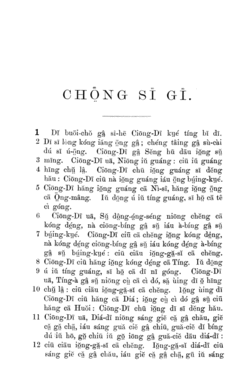Dialect of Northern Min Chinese
Bible in Jian'ou Romanised (Genesis ), published by the British and Foreign Bible Society . The Jian'ou dialect (Northern Min : Gل¹³ج؟ing-أ©-dؤ« / ه»؛甌ن؛‹ Chinese : simplified Chinese : ه»؛ç“¯è¯ ; traditional Chinese : ه»؛甌話 ; pinyin : Jiأ n'إچuhuأ Kienow dialect , is a local dialect of Northern Min Chinese spoken in Jian'ou in northern Fujian province. It is regarded as the standard common language in Jian'ou.
Phonetics and phonology
According to The Eight Tones of Kien-chou ه»؛ه·ه…«éں³ rime dictionary published in 1795, the Jian'ou dialect had 15 initials, 34 rimes and 7 tones in the 18th century, however there are only 6 tones in the modern dialect as the "light level" (陽ه¹³
Initials
Rimes
Tones
Jian'ou has four tones, which are reduced to two in checked syllables.
Tone chart of the Jian'ou dialect
Tone number
Tone name Tone contour
1
level (ه¹³èپ²
ث¥ث¦ (54) or ث¥ (5)
2
rising (ن¸ٹèپ²
ث¨ث© (21) or ث© (1)
3
dark departing (é™°هژ»
ث§ (3)
4
light departing (陽هژ»
ث¦ (4)
5
dark entering (é™°ه…¥
ث¨ث¦ (24)
6
light entering (陽ه…¥
ث¦ث¨ (42)
The entering tones in the Jian'ou dialect do not have any entering tone coda (ه…¥èپ²éں»ه°¾ /-ت”/ , /-pجڑ/ , /-tجڑ/ and /-kجڑ/ which makes it distinct from many other Chinese varieties.
Notes
^ Min is believed to have split from Old Chinese, rather than Middle Chinese like other varieties of Chinese.[ 1] [ 2] [ 3]
References
^ Mei, Tsu-lin (1970), "Tones and prosody in Middle Chinese and the origin of the rising tone", Harvard Journal of Asiatic Studies , 30 : 86– 110, doi :10.2307/2718766 , JSTOR 2718766 ^ Pulleyblank, Edwin G. (1984), Middle Chinese: A study in Historical Phonology , Vancouver: University of British Columbia Press, p. 3, ISBN 978-0-7748-0192-8 ^ Hammarstrأ¶m, Harald ; Forkel, Robert; Haspelmath, Martin ; Bank, Sebastian (2023-07-10). "Glottolog 4.8 - Min" . Glottolog Leipzig : Max Planck Institute for Evolutionary Anthropology . doi :10.5281/zenodo.7398962 Archived from the original on 2023-10-13. Retrieved 2023-10-13 .^ /e/ tends to merge to [ةھ]
^ /o/ tends to merge to [تٹ]
^ /oإ‹/ which is mentioned in Kienning Colloquial Romanized has merged into /ة”إ‹/ in the modern dialect.^ /ieiإ‹/ is not mentioned in Kienning Colloquial Romanized as it diverged from /iإ‹/ after the romanization system was established.^ a b /yة›/ tends to merge into /uة›/ .^ a b /yiإ‹/ tends to merge into /uiإ‹/ .
Sources
Beijing daxue Zhongguo yuyan wenxue xi yuyanxue jiaoyanshi هŒ—ن؛¬ه¤§ه¸ن¸هœ‹èھ言و–‡ه¸ç³»èھ言ه¸و•™ç ”ه®¤ (1989). Hأ nyا” fؤپngyؤ«n zأ¬huأ¬ و¼¢èھو–¹éں³ه—هŒ¯ (in Chinese). Beijing: Wenzi gaige chubanshe. Yuan, Jiahua è¢په®¶é©ٹ (1989). Hأ nyا” fؤپngyأ،n gأ iyأ o و¼¢èھو–¹è¨€و¦‚è¦پ [An Introduction to Chinese Dialects ] (in Chinese). Beijing: Wenzi gaige chubanshe. Jianou Xian difangzhi bianzuan weiyuanhui ه»؛瓯هژ؟هœ°و–¹ه؟—ç¼–ç؛‚ه§”ه‘کن¼ڑ (1994). Jiأ nإچu xiأ nzhأ¬ ه»؛瓯هژ؟ه؟— Chorography of Jian'ou County ]. Vol. 36. Beijing: Zhonghua shuju . ISBN 7-101-01283-3 the original on 2018-04-07. Retrieved 2018-04-06 . Lien, Chinfa (1990). "Competing Final Systems in the Jian'ou Dialect" (PDF) . Tsing Hua Journal of Chinese Studies . 20 (1): 1– 53. Norman, Jerry (2002) [1988]. Chinese . Cambridge: Cambridge University Press. ISBN 0-521-29653-6
External links
History, phonology, and grammar
Written Chinese and input methods
Research
Proto-languages Rime dictionaries
















